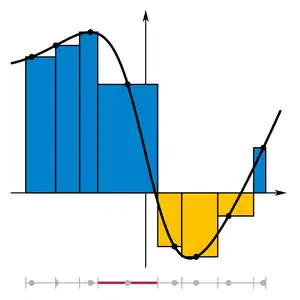Partition of an interval
In mathematics, a partition of an interval [a, b] on the real line is a finite sequence x0, x1, x2, ..., xn of real numbers such that
- a = x0 < x1 < x2 < ... < xn = b.

In other terms, a partition of a compact interval I is a strictly increasing sequence of numbers (belonging to the interval I itself) starting from the initial point of I and arriving at the final point of I.
Every interval of the form [xi, xi + 1] is referred to as a subinterval of the partition x.
Refinement of a partition
Another partition of the given interval, Q, is defined as a refinement of the partition, P, when it contains all the points of P and possibly some other points as well; the partition Q is said to be “finer” than P. Given two partitions, P and Q, one can always form their common refinement, denoted P ∨ Q, which consists of all the points of P and Q, re-numbered in order.[1]
Norm of a partition
The norm (or mesh) of the partition
- x0 < x1 < x2 < ... < xn
is the length of the longest of these subintervals[2][3]
- max{|xi − xi−1| : i = 1, ... , n }.
Applications
Partitions are used in the theory of the Riemann integral, the Riemann–Stieltjes integral and the regulated integral. Specifically, as finer partitions of a given interval are considered, their mesh approaches zero and the Riemann sum based on a given partition approaches the Riemann integral.[4]
Tagged partitions
A tagged partition[5] is a partition of a given interval together with a finite sequence of numbers t0, ..., tn − 1 subject to the conditions that for each i,
- xi ≤ ti ≤ xi + 1.
In other words, a tagged partition is a partition together with a distinguished point of every subinterval: its mesh is defined in the same way as for an ordinary partition. It is possible to define a partial order on the set of all tagged partitions by saying that one tagged partition is bigger than another if the bigger one is a refinement of the smaller one.
Suppose that x0, ..., xn together with t0, ..., tn − 1 is a tagged partition of [a, b], and that y0, ..., ym together with s0, ..., sm − 1 is another tagged partition of [a, b]. We say that y0, ..., ym and s0, ..., sm − 1 together is a refinement of a tagged partition x0, ..., xn together with t0, ..., tn − 1 if for each integer i with 0 ≤ i ≤ n, there is an integer r(i) such that xi = yr(i) and such that ti = sj for some j with r(i) ≤ j ≤ r(i + 1) − 1. Said more simply, a refinement of a tagged partition takes the starting partition and adds more tags, but does not take any away.
References
- Brannan, D. A. (2006). A First Course in Mathematical Analysis. Cambridge University Press. p. 262. ISBN 9781139458955.
- Hijab, Omar (2011). Introduction to Calculus and Classical Analysis. Springer. p. 60. ISBN 9781441994882.
- Zorich, Vladimir A. (2004). Mathematical Analysis II. Springer. p. 108. ISBN 9783540406334.
- Ghorpade, Sudhir; Limaye, Balmohan (2006). A Course in Calculus and Real Analysis. Springer. p. 213. ISBN 9780387364254.
- Dudley, Richard M.; Norvaiša, Rimas (2010). Concrete Functional Calculus. Springer. p. 2. ISBN 9781441969507.
Further reading
- Gordon, Russell A. (1994). The integrals of Lebesgue, Denjoy, Perron, and Henstock. Graduate Studies in Mathematics, 4. Providence, RI: American Mathematical Society. ISBN 0-8218-3805-9.